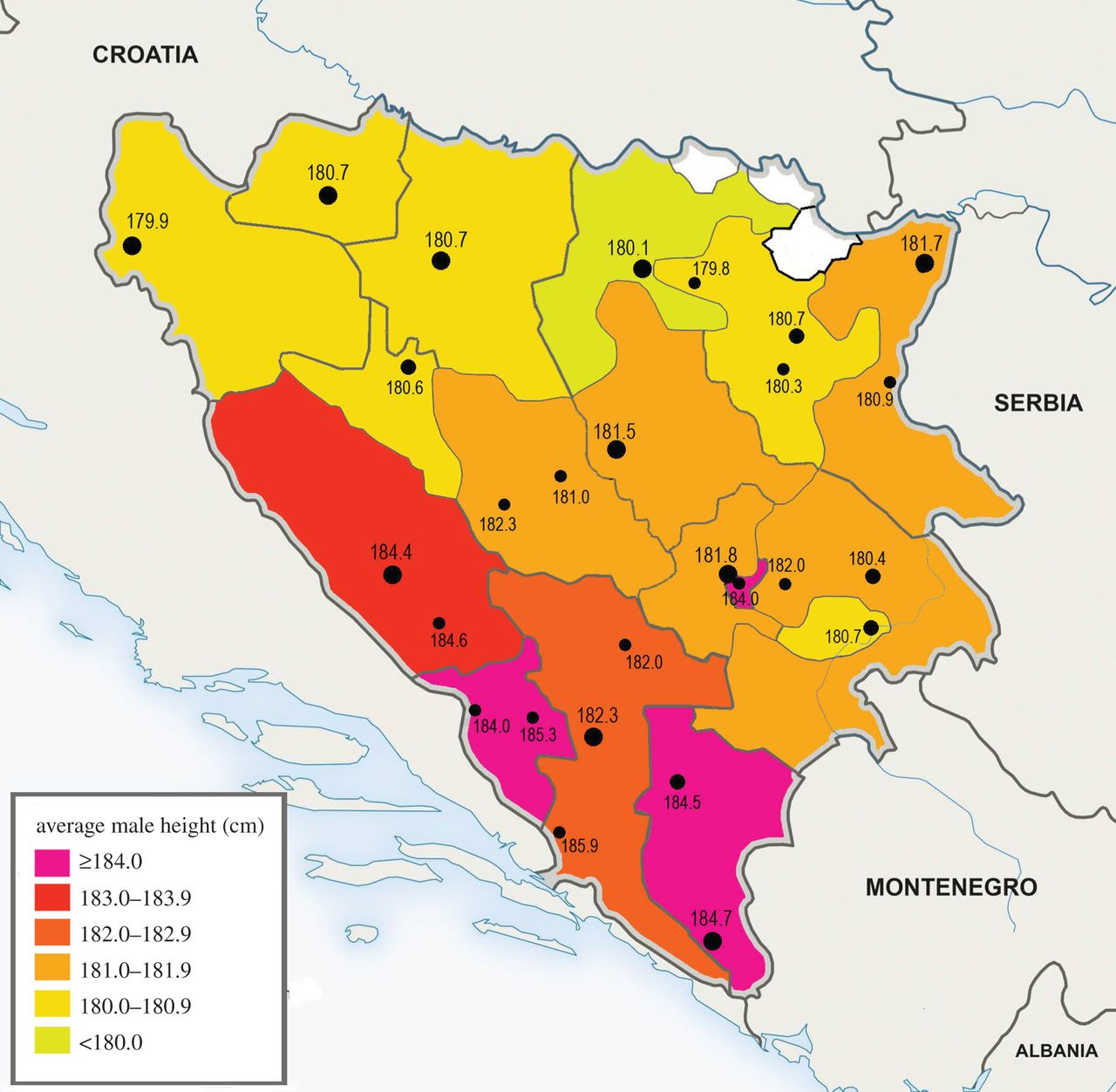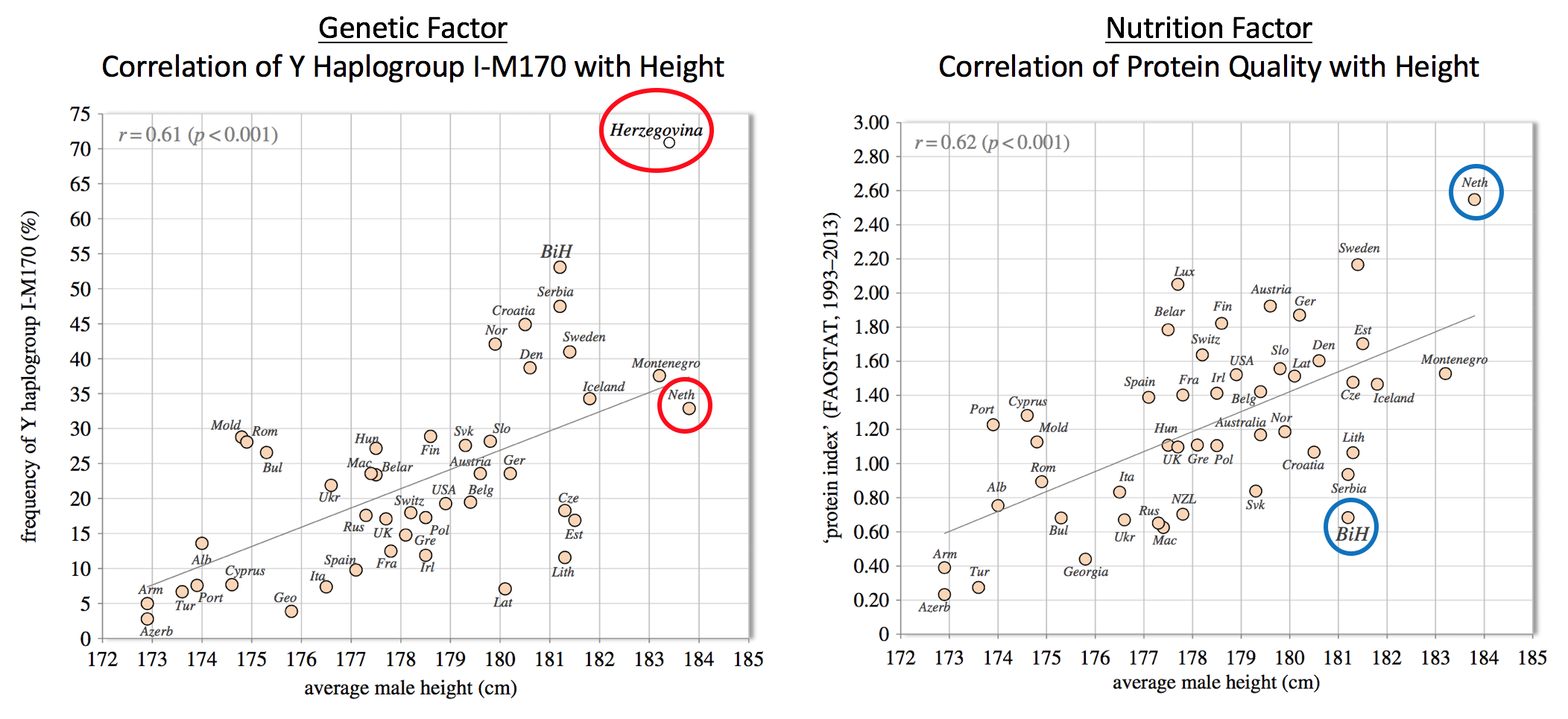The Dutch are famous for windmills, impressive feats of geoengineering, and being tall and blonde. At a towering 183.8 cm (just over 6 feet tall), Dutch men are widely hailed as the tallest in the world. But new data suggests that men from regions within the Balkan country of Bosnia and Herzegovina (B&H) are even taller.
The inhabitants of B&H display a large variation in average height. This is due to a combination of factors, such as genetics, religion, and socioeconomics. B&H is a multiethnic country, so the genetic background of its citizens is varied. Religion influences a person's dietary choices (e.g., Muslims avoid pork), while socioeconomic status affects the nutritional value of the food that a person can obtain. Just over half the population of B&H is Muslim, and the country is one of the poorest in Europe.
 Research published in 2005 showed that individuals from the Dinaric Alps -- a mountain range that spans several countries, including B&H -- were the tallest in Europe1. That study, however, only examined adolescents (aged 17 years) and did not acquire regional data. So an international team of Eastern European researchers, led by Pavel Grasgruber of Masaryk University in Czech Republic, went back to B&H to obtain more detailed demographic information.
Research published in 2005 showed that individuals from the Dinaric Alps -- a mountain range that spans several countries, including B&H -- were the tallest in Europe1. That study, however, only examined adolescents (aged 17 years) and did not acquire regional data. So an international team of Eastern European researchers, led by Pavel Grasgruber of Masaryk University in Czech Republic, went back to B&H to obtain more detailed demographic information.
The team surveyed 37 towns in B&H, and it measured the heights of 3,192 men who were 17 to 20 years old. Average height in each region (given in cm) is shown on the right.
The tallest citizens of B&H lived in Herzegovina (the southern part of the country through which the Dinaric Alps cross), who measured on average 183.6 cm, a mere 0.2 cm shy of the Dutch. But in some regions of Herzegovina, the average man was 184 cm or taller2. In the Trebinje region at the southern tip of the country, the men were 184.5 cm, besting the Dutch by more than a quarter of an inch.
The Tall Mountain Men of Herzegovina
What explains the height of Herzegovinians? The team believes two primary factors are at play, but they have opposing effects.
A particular genetic profile in men (called Y haplotype I-M170) is correlated with height. (See graph on left below.) Ecological data3 shows that as the frequency of this genetic profile increases in the population, the average male height in a country also increases. In the Netherlands, about 35% of men have this genetic profile, but in Herzegovina, the frequency is over 70%. Extrapolating the genetic trend line suggests that the average Herzegovinian man could possibly be as tall as 190 cm (nearly 6' 3").

But the average male Herzegovinian isn't that tall. Why? That's where the other factor, nutrition, comes into play. Average male height in a nation is also correlated with protein quality. Nations that consume more protein in the form of pork, dairy, eggs, and fish tend to be taller, while those that attain more protein from cereals tend to be shorter. (The graph on the right shows that the Dutch have a diet rich in high-quality protein, while Bosnians and Herzegovinians do not.)
Because of the large Muslim population, many Herzegovinians don't eat pork. In an email to ACSH, Dr. Grasgruber says that the religious prohibition on pork may be largely to blame for the shorter average stature of Herzegovinians. Indeed, regions with a greater fraction of Muslims were shorter than regions with fewer Muslims. Additionally, poverty plays a role, as citizens of B&H were 1.9 cm taller if both of their parents went to university.
Together, the data suggests that Herzegovinians have the genetic potential to be more than two inches taller than the Dutch, but many currently do not achieve that potential due to nutritional choices and poverty.
Can we ever expect the Herzegovinians to surpass the Dutchmen? Yes, "give it 20-30 years," Dr. Grasgruber said. We'll check back on them in the year 2040.
Notes
(1) The study found the average 17-year-old male from the Dinaric Alps was 185.6 cm (over 6' 1").
(2) The average 17-20-year-old man in the town of Čapljina was 185.9 cm, the tallest in B&H.
(3) The weakness inherent in ecological studies is explained here.
Source: Pavel Grasgruber, et al. "The mountains of giants: an anthropometric survey of male youths in Bosnia and Herzegovina." R Soc Open Sci. Published: 12-Apr-2017. DOI: 10.1098/rsos.161054




